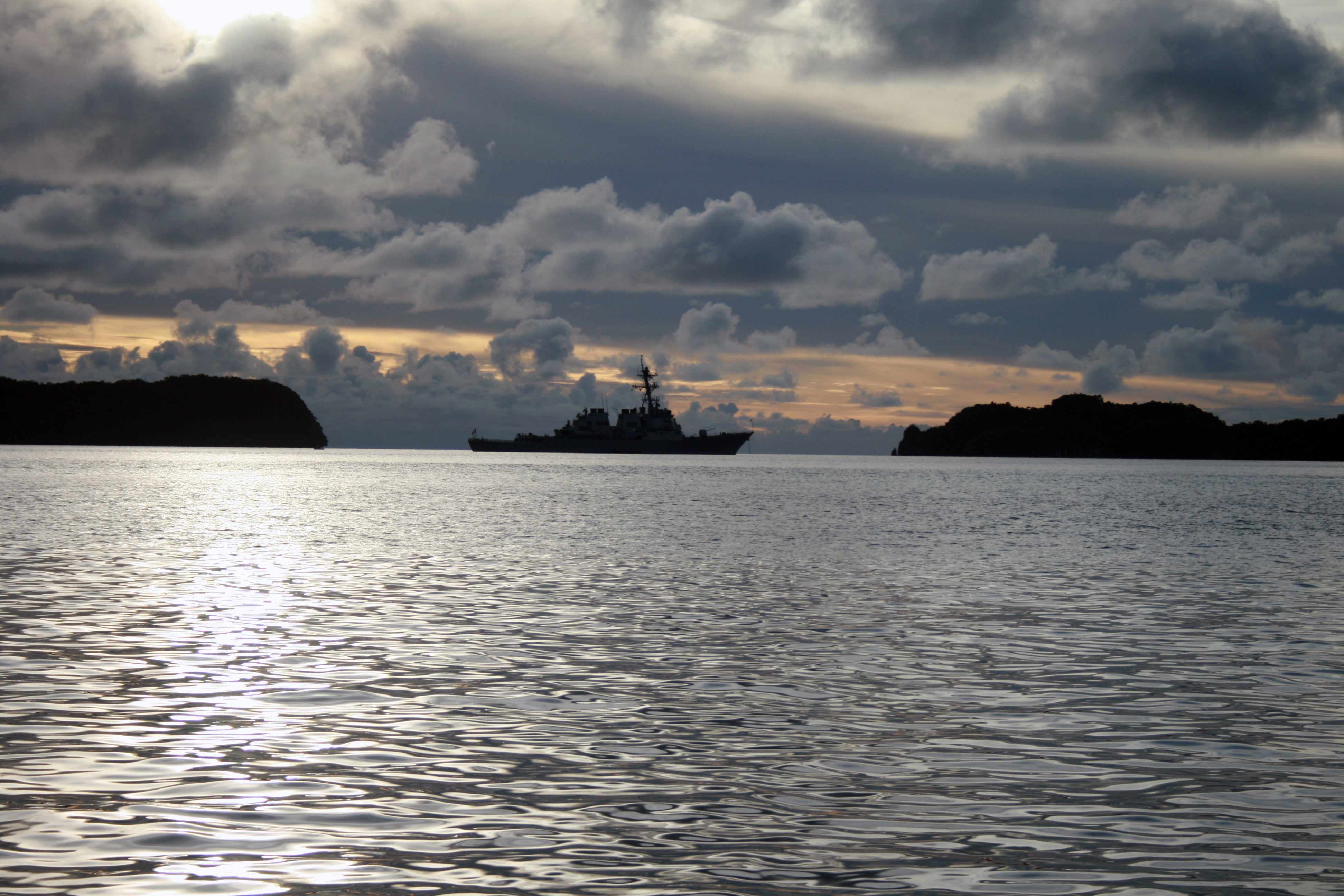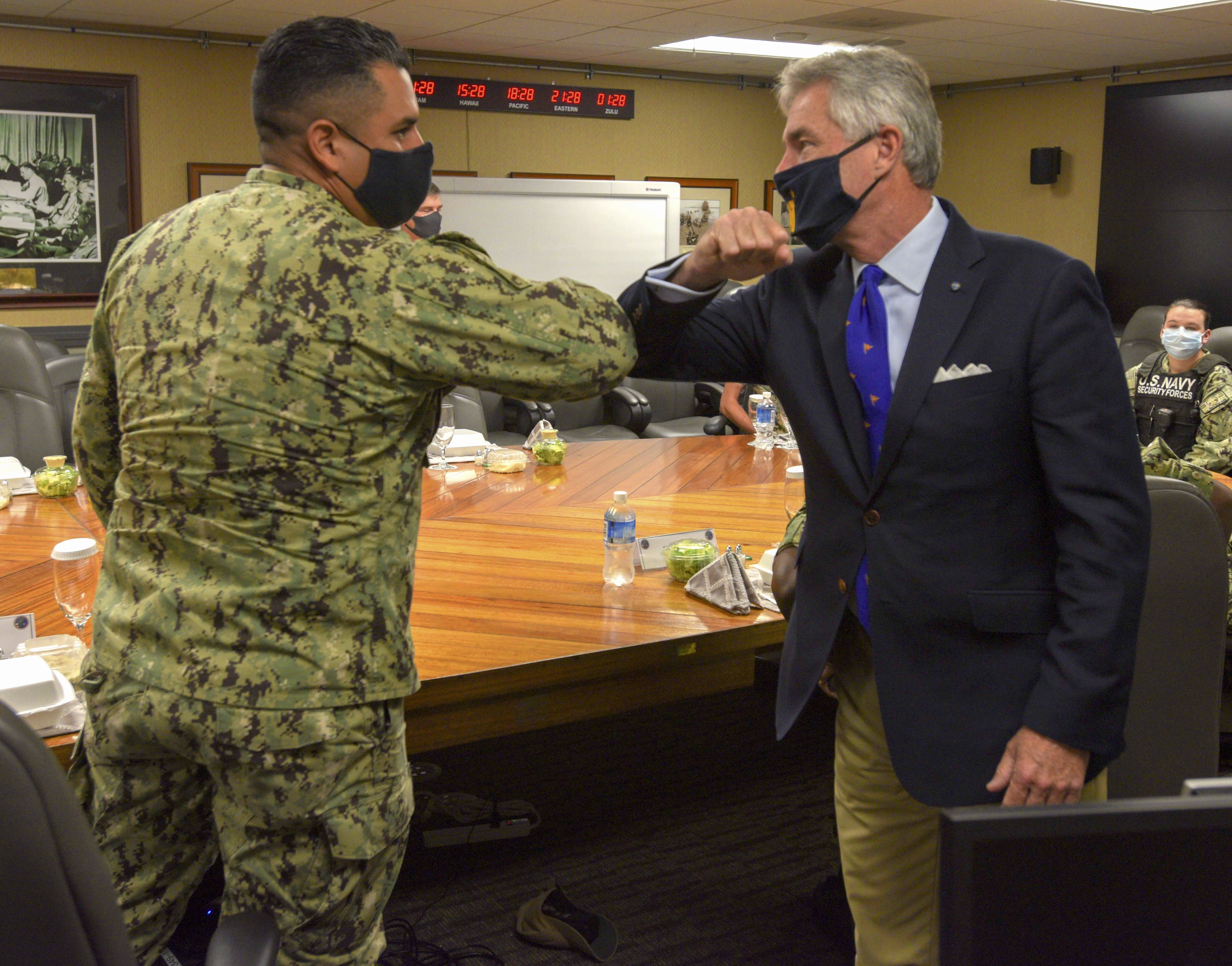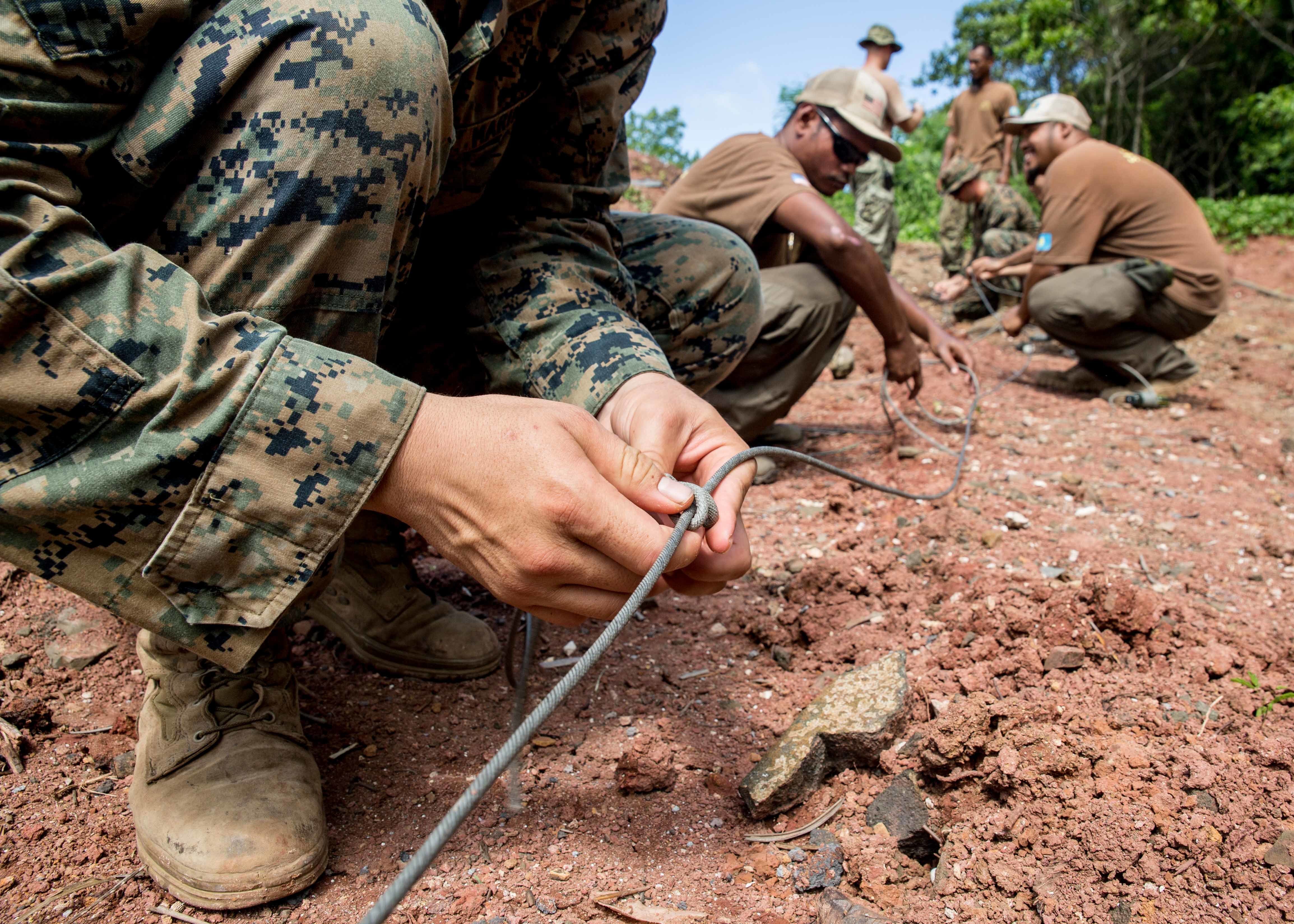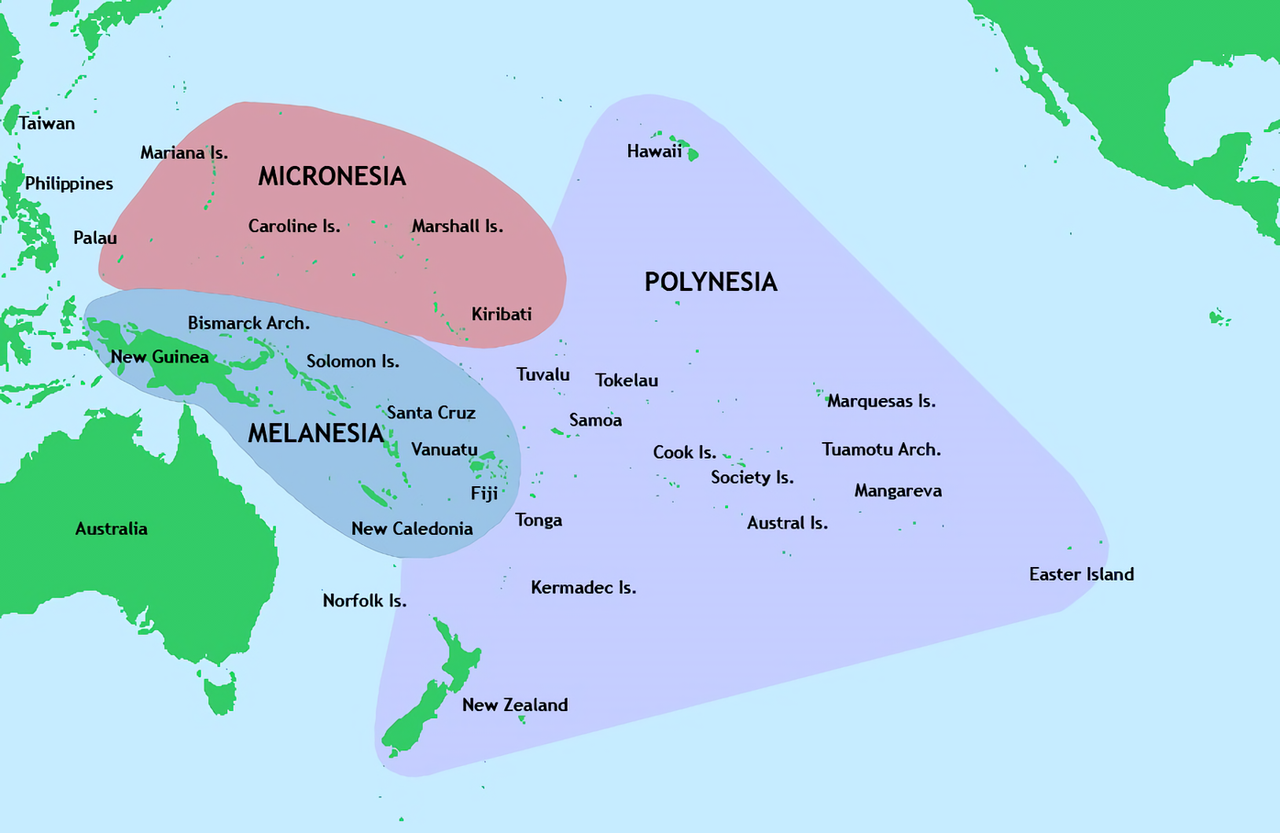
Navy Secretary Kenneth Braithwaite visited Palau during a weeklong swing through the Pacific, making him the second high-ranking Defense Department official to visit to the small island nation in the last two months as the Second Island Chain is being eyed to play an even larger role in military plans and operations going forward.
The SECNAV visited Japan, Singapore, Guam and the Republic of Palau in his trip from Oct. 13 to 20, meeting with troops stationed throughout the Pacific but also meeting with military and political leaders to shore up partnerships in a bid to keep the peace even as China grows more aggressive in the region.
“Strengthening these relationships through enhancing interoperability and executing maritime security and awareness operations are vital to maintaining a competitive advantage in this complex global security environment,” Braithwaite in a news release.
“None of this would be feasible without the forward-deployed Sailors, Marines and civilians whose efforts of which I could not be more proud.”
During the visit he met with leaders in Japan and Singapore – Japanese Defense Minister Nobuo Kishi and Japan Maritime Self Defense Force (JMSDF) leadership, as well as Singapore’s Minister for Defence Ng Eng Hen and Chief of the Defence Force Lt. Gen. Melvyn Ong – to discuss U.S. Navy operations in two well established Pacific hubs. Most of the Navy’s forward-deployed ships in the Pacific are based out of Japan, with the Littoral Combat Ships operating out of Singapore.
The other two stops represent growing opportunities for the Navy and Marine Corps.
Five years after the Department of the Navy officially signed off on a plan to move about 5,000 Marines from Okinawa, Japan, to Guam – in an effort to spread out Marine Corps presence throughout the Pacific – Marine Corps Base Camp Blaz on Guam was formally activated earlier this month. According to the news release, Braithwaite met with Governor Lou Leon Guerro before visiting with Marines at Camp Blaz, where approximately 5,000 Marines from III Marine Expeditionary Force will begin relocating over the next few years. These Marines will join the sailors already located on the island at Naval Base Guam.
In his final stop of the trip, SECNAV met with Palau President Tommy Remengesau and members of his cabinet to discuss the Department of the Navy’s presence and commitment to security and stability in the region, especially the Pacific Islands, according to the news release. Defense Secretary Mark Esper in August visited Palau during a similar tour through the Pacific and also met with Remengesau.
According to notes from the meeting between Braithwaite and Remengesau provided to USNI News, Braithwaite said that “allies are more important than ever and Palau’s strategic location was extremely important to U.S. presence in the region. He acknowledged that the visit shortly following SECDEF visit was a show of commitment to Palau and the region. The visit served an important purpose and the Secretary thanked the President to allow his visit and to meet with him.”
Braithwaite also said there was a new world order now, which the U.S. welcomed as long as everyone is playing by the same rules and respects freedom of the seas. As part of that new world order, SECNAV committed to Palau “enhanced presence here and for more U.S. military activity in the future.”

A Pentagon spokesman told USNI News today that the U.S. was committed to working with like-minded partners and allies in defense of a free and open Indo-Pacific and that Palau specifically was a close partner codified through the Compact of Free Association.
“The DoD’s focus is on access to places from which to operate, not necessarily new permanent bases. For example, in Palau during Exercise Koa Moana, U.S. Marines refurbished an airfield, which facilitated the arrival of a C-130 bringing U.S. Army troops as part of Exercise Defender Pacific. We have, continuously since 1969, maintained the rotational presence of a Civic Action Team that engages with the local population, providing basic medical services, training in vocational and technical skills, and building small construction projects that address local needs. Thus far, the Department has provided more than $5.3 million in COVID mitigation assistance throughout the Pacific Island Countries, including in Palau,” Lt. Col. Chris Mitchell said.
Though there may not be an interest in permanently stationing forces there, akin to what’s happening on Guam, the notes from Braithwaite’s meeting in Palau notes that “the United States Navy is interested in expanding its naval presence in the Indo-PACOM region and increasing operations around Palau.”
“There is a narrow window for the U.S. and allies, large and small, to work together in a more integrated fashion to act as a deterrent to Chinese aggression,” the notes continue.
Derek Grossman, a senior defense analyst at RAND Corporation, wrote last month in The Diplomat that the Freely Associated States of Palau, the Marshall Islands and Micronesia, through the Compact of Free Association, gives Washington “virtually unrestricted military access to the entire FAS region, which contains open ocean approximately the size of the continental United States.”
However, China is making moves to try to sway the island nations to change alliances, and in one case Beijing is lobbying a single island in Micronesia to break free, break up the COFA and give China a foothold in the Second Island Chain.
In light of the strategic importance of this northernmost section of Oceania, Remengesau not only asked Esper to set up military facilities in Palau but also hand-delivered a letter to Braithwaite with the same message: “that Washington had a steadfast ally in Palau and should look at setting up facilities there and elsewhere in the Northern Pacific region,” according to a Radio New Zealand article on Oct. 21.
“We are living in uncertain times and I think this is a great opportunity, not just for Palau, but for the region, to look at our special relationship and see what the leadership of the United States can do in this day and age,” Remengesau said, according to the article.
“Some of Palau’s chief infrastructure needs, including port facilities, secondary airfields, law enforcement training grounds and maritime enforcement and surveillance facilities, are also opportunities to strengthen US military readiness,” Remengesau said in the letter.

Grossman wrote last month after Esper’s visit to Palau that “as U.S.-China great power competition continues to ramp up, Washington has grown uneasy about Beijing’s power projection capabilities, particularly its conventional ballistic and cruise missiles, that can now saturate the First Island Chain and increasingly threaten U.S. military positions in the Second Island Chain. Hence, Washington is very likely to continue shoring up its defensive posture in the Second Island Chain to support joint operations in First Island Chain theaters, including in the Taiwan Strait, East China Sea, and South China Sea. To accomplish this task, Washington will almost certainly seek to strengthen security cooperation with Pacific Island states in the Second Island Chain and bolster defensive positions on U.S. territories in the region.
“Ultimately, Washington probably believes it needs to retain exclusive access to the Second Island Chain as an insurance policy in the event that Beijing successfully denies the United States and allies access to the First Island Chain theater or, even worse, repels them from it,” his article in The Diplomat continues.
Retaining the freedom to maneuver throughout the FAS region could allow the U.S. to project forces from the West Coast to Hawaii to these island nations and then up to Guam relatively uncontested, allowing the U.S. military to build up forces and supplies and then figure out how to get back into the First Island Chain if they had been repelled out, or surge more forces in to support the joint forces already operating within the weapons engagement zone of the Chinese.
Access to the First Island Chain isn’t only threatened by long-range weapons China is fielding that could put military forces in harm’s way; it’s also being limited by local partners and allies who don’t want to come between the U.S. and China. The U.S. had requested that Indonesia allow the Navy’s P-8A Poseidon maritime surveillance planes to land and refuel there, and despite high-level government talks throughout the summer, Indonesia formally rejected the request this week, Reuters first reported.
 “The proposition, which came as the U.S. and China escalated their contest for influence in Southeast Asia, surprised Indonesia’s government, the officials said, because Indonesia has a long-standing policy of foreign policy neutrality. The country has never allowed foreign militaries to operate there,” according to the Reuters report.
“The proposition, which came as the U.S. and China escalated their contest for influence in Southeast Asia, surprised Indonesia’s government, the officials said, because Indonesia has a long-standing policy of foreign policy neutrality. The country has never allowed foreign militaries to operate there,” according to the Reuters report.
Additionally, the Philippines allows U.S. Navy port calls and has been eyed as a potential place to expand Littoral Combat Ship operations, for example, but political leadership there has been hot and cold on U.S. access this year. With uncertainty within the First Island Chain, it would become all the more important to shore up access in the Second Island Chain.
In addition to Braithwaite’s and Esper’s recent visits, Japan-based USS Comstock (LSD-45) and Guam-based U.S. Coast Guard Cutter Sequoia (WLB-215) sailed through Palau’s waters, and a team from the U.S. Air Force also arrived on Palau to assess grant aid requirements and evaluate serviceability of the runways and tarmacs of airfields, according to RNZ.
These recent overtures to Palau aren’t the only ones, though. Grossman notes in his article that, in addition to Esper being the first defense secretary to visit Palau, in May 2019 President Donald Trump became the first president to meet with all three FAS leaders at the White House, and in August 2019 Secretary of State Mike Pompeo became the first sitting secretary to visit Micronesia.





